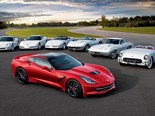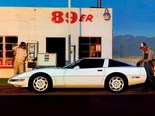Chevrolet Corvette C4 (1984-89): Buyers Guide
First new 'vette in 16 years brought modern tech to the yank icon

|
|
Buyer's Guide: 1984-89 Chevrolet Corvette C4
|
1984 - 1989 Chevrolet Corvette C4
WHAT IS IT?
The Corvette is America's Ferrari and the best-selling sports car in the US. While the C4 is not as desirable as a 'split-window' or early big-block C2, the fourth-gen 'Vette is value-for-money.
The 1984 C4 was the first all-new Corvette since '68 and continued the fibreglass-body, front-engine, rear-drive tradition but was clothed in a more aerodynamic body - its raked windscreen, sleek body and low ride height cutting its drag coefficient to 0.34. Weight was reduced by extensive use of aluminium and a removable glass roof panel and rear hatch slightly improved interior space. Less popular was the new digital dash.
Ticking the Z51 performance option box (fitted to 50 percent of '84 C4s) added bespoke 255/50 VR16 Goodyear Eagles and stiffer springs, which improved the already impressive grip and handling, but the kidney-rattling ride eventually forced engineers to soften spring rates.
When it was launched, the C4 copped a hefty price hike but that was off-set by a standard leather steering wheel and gearknob, remote mirrors, air-con, halogen headlights, fog lights and alarm with immobiliser. With 'Cross-Fire' throttle-body fuel injection and a 9.0:1 compression ratio, the 350ci V8 made 153kW/393Nm. Transmissions were a four-speed Turbo 700 or four-speed manual with computer-controlled overdrive in second, third and fourth.
A new L98 V8 engine arrived in 1985 and power and torque increased to 172kW/447Nm. In 1986, the first convertible 'Vette in 11 years was launched as well as Bosch anti-lock brakes. A softer Z52 sports handling package, with Bilstein shocks, 9.5-inch wide alloys, quicker steering rack and larger front sway bar became optional in '87 and outputs rose to 179kW/468Nm.
An extra $20,000 bought the 300km/h Callaway twin-turbo option with 257kW/610Nm. A ZF six-speed manual, 17-inch alloys, and selective ride control were introduced in 1989.
HOW'S IT DRIVE?
Despite its external dimensions, the C4 is strictly a two-seater, where you sit low and deep in electric sports seats. The footwell is cramped, especially if it's a RHD conversion, which makes it worse.
The digital dash and switchgear is comprehensive but can be distracting and confusing. The 4-plus-3 gearbox is clunky - around town, the auto is the trick. With 453Nm of torque, 0-100km/h takes around six seconds. Handling is flat and sure-footed, the steering is direct, and the ABS brakes are powerful.
CHECKLIST
Poor conversions are best avoided and cost a lot to rectify. Check for signs of damage and cheap repairs. The build quality of post-'83 cars is good so misaligned panels should ring alarm bells. Rust can be a problem on metal parts and harsh sun can make the fibreglass body brittle.- The trusty, small-block Chev is durable if well maintained. Worn valve guides are the most common problem. The 4-plus-3 'box is difficult and expensive to repair. The ZF is better but parts are hard to source. Many suspension parts are aluminium and durable but rear spring bushes wear. Selective ride control can be expensive to fix and the electronic dash is costly to replace.
SPECIFICATIONS
1984-1989 Chevrolet Corvette C4
Body: 2-door coupe, 2-door convertible
Engine: 5763cc V8, OHV, 16v
Power: 179kW @ 4000rpm*
Torque: 468Nm @ 3200rpm*
Weight: 1465kg*
Gearbox: 4- or 6-speed manual, 4-speed automatic
Brakes: discs (f/r)
Price range: $8000-27,500
* 1987 Corvette Coupe
Unique Cars magazine Value Guides
Sell your car for free right here
Get your monthly fix of news, reviews and stories on the greatest cars and minds in the automotive world.
Subscribe

.jpg)





.jpg)




